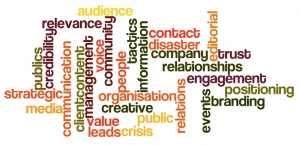Hiring a public relations (PR) agency is one way to manage communication between you and the public—your potential customers—but how do you know if it’s what you need for your business?
Practitioners consider PR as the management of communication between an organisation and the public to preserve or enhance the reputation of that organisation. In many cases, PR has a promotional function, where the PR agent facilitates positive media coverage through media, social media and other communication channels. Sometimes organisations use PR to limit brand damage during a disaster, for example if a CEO says something offensive on national TV or there’s a public outcry about the organisation’s activities.
PR versus publicity
One common misconception is that PR is just publicity. The truth is, it’s more complex than publicity. PR is a management function and works towards creating a mutual understanding between a business and its customers/audience.
Sure, sometimes it’s about publicity but it is also about getting the right messages across and influencing key stakeholders to become advocates of your business. It’s not just about getting your name in the paper; it needs to be on-brand, strategic and influential. PR works when it’s embedded with your brand strategy, not just to produce hype.
PR on call
Some people believe you only need PR during certain times, for example, when the organisation is in crisis mode. If you’re calling on PR experts for the first time during a crisis, I’d suggest it’s too late!
Because PR is a management function, handling negative publicity occurs even before the crisis hits. A good PR agent will have a risk management plan that will include the levers to pull when things go wrong. To be truly effective, PR needs to be ongoing. There really is no such thing as a quick fix and generally, if you’ve focused on building up the right reputation for your business for a while, it is much easier to fix a problem than starting from nowhere.
PR belongs in the news
Positive media coverage is great for your business, but the idea that everything new is news and should be brought to the press’ attention is a fallacy. Many businesses confuse something new with something newsworthy. Media outlets are looking for the latter; media coverage is not free advertising.
If your message is something that you would normally use an advertisement to say, for example, announcing that your business is having a stocktake sale or that you are better than your competitors, then this is not newsworthy.
Can I be honest with you for a second? No one cares that you believe your business is ‘awesome’ or ‘leading’. A journalist is not going to share information like that with their audience who took time to read/listen/view the article or program. Would you enjoy reading about how your competitors claim they are the best? I thought not… Enough said.
A PR practitioner will find the right angle to make something newsworthy. Instead of bragging about how great your business is, the right kind of PR will show how great your business is by sharing your expertise or case studies, or by communicating your newsworthy activities, whether that’s winning an award, doing important research or performing noteworthy acts.
PR is a way to manage communications to show the world the best parts of your brand and enhance your, or your organisation’s, reputation. If this is a function you’d like to include in your communications activities to help your business thrive, get on board.
Understanding PR
Public relations is an industry that most people are a bit hesitant to put an exact description on. It is such a multi-faceted role that assigning it one definition is tricky. However, the official definition of public relations according to the PRSA is “Public relations is a strategic communication process that builds mutually beneficial relationships between organisations and their publics.”
In essence, the best PR companies are excellent storytellers that can create meaningful narratives that help their clients achieve a specific goal. Whether that’s convincing consumers to buy a new product, creating a connection with local communities, communication with employees and shareholders, or dealing with negative reviews or publicity.
As you can see, there is no single job for PR companies and their role will evolve according to the industry that their clients are in, the growth of companies, and the core values of the businesses that they are representing. Understanding PR is about understanding people: how they perceive the company, how to connect with them, and how to influence their perceptions to meet the end goal.
Thought Leadership
A thought leader uses their expertise to share bold positions and advice on best practice. They believe that their view is either different to common practice or that they can shed light on an area that an audience wouldn’t understand. To be a real thought leader, you need to ask yourself what you do well, and then narrow that down to what you can have an opinion on based on your experience and your expertise. Why does it matter to anyone and why would they care?
As a thought leader, you need to have some credible proof points. Here’s a test for better understanding PR thought leadership: Have you got case studies that back up what you’re saying, or reputable endorsements or research that demonstrate the trends that match your statements? Do you have well-respected connections, or years of experience? Are you generous? If you answer yes to these questions, then you’ll be well on your way to genuine thought leadership.
Press Releases
The press release remains an important way to get stories in the hands of journalists. You might even think it sounds like an old-fashioned way to do things, but trust us… it works. And if it’s not working for you, you’re probably doing it wrong.
When it comes to press releases, we advise our clients to go against popular opinion to keep releases ‘short and snappy’ – packing a release with lots of info means less work for the journalist. Leave your power for your pitch, not your press release. If journalists ‘don’t read’ the release, then your pitch must be killer. There is no such thing as too many quotes. Record everything. You are selling your clients – their business, their thoughts – this is the key to most of your coverage so the more quotes the better.
Articles and Blogging
Try to remember that when choosing where to spend their money, people aren’t always comparing tertiary qualifications or obsessing over how many years’ experience you have. Instead, their decision is typically based on familiarity, credibility and helpfulness. They’re looking for the person who can give them the most assistance, both prior to the first inquiry in the form of articles, interviews, videos and helpful blog posts, and in all the interactions they have after they make contact.
Bylined articles, opinion pieces and thought leadership pieces are another great way to get your name and your business out there. Writing articles and blogs for external publications shows not only a deep expertise in your industry, but also has the helpful side-effect of raising your profile in search rankings. Your potential customers can come through many different channels, either looking for advice or a specific product and if your website becomes an unrivalled resource for information, the greater the chances are that these individuals will end up buying from you.
Face-to-Face Engagement
Yes, face-to-face sales still happen! But it’s no longer necessary for companies to send out their salespeople door-to-door. One only has to look at the tech industry to see the value of public engagement events, conferences and well-planned launch parties. In large companies, they can sometimes take on a monolithic appearance, sometimes filling stadiums like a rock concert. No one is suggesting you hire out an arena, but it does illustrate the importance some companies place on launch events.
What is key to these events, whether you are doing product PR or public relations at an exhibit, is that you have a spokesperson who can speak confidently and knowledgeably. Your spokesperson can use their platform as a way of telling the story of your service, offering an insight into your company that draws people in and establishes you as a thought leader, unrivalled in the industry. Pure Public Relations in Sydney can help with speech writing, developing scripts, and providing publicity for conferences and events.
It’s also important to understand that PR companies come in a variety of shapes, sizes, and specialisations. Companies like us specialise in publicity, media relations, issues management and crisis communications, internal communication, and government relations for small and medium-sized businesses and not-for-profits, but there are companies that only work with big corporations and PR firms that only in disaster management. Therefore, it’s essential that businesses find the right PR company to suit their unique needs.
Public Relations and Communications
At the heart of every successful PR company or firm is their ability to harness the power of genuine messaging that will resonate with and impact the intended audience. Just some of the public relations and communication tools that pr companies use are:
- Writing and distributing press releases
- Thought leadership articles and interviews, such as feature articles, profiles, bylined articles like advice articles and opinion pieces
- Writing speeches
- Special events for promotions of particular products and services
- A company’s brand voice for internal and external communication
- Crises strategies
- Blogging
- Social media marketing and responding to negative and positive customer engagement
Public relations companies have a wealth of connections with important communication stakeholders like journalists, broadcasters and other media outlets that they use to disseminate information for their clients. It’s essential that public relations isn’t confused as simply being a form of communication, as it is much more. While communication is at the core of a public relations company’s job, it’s merely a vessel that they use to get the right message to the right people at the right time.
Crafting compelling, meaningful content and getting it out to the right audience in the best way is at the heart of PR. Simply putting a message out there and hoping for the best isn’t going to get the desired results. PR companies are experts in market research and will go the extra mile to understand the intended audience in order to create messaging that is going to resonate them and influence their behaviours in an intended manner.


